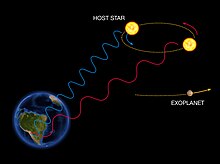Alpha Centauri Bb
[10] The team made 459 observations of Alpha Centauri B's color spectrum over a four-year period, then used statistical filters to remove known sources of variance.
[2] The discovery was presented in the scientific journal Nature, with lead author Xavier Dumusque, a graduate student at the University of Porto.
The transformations filtered out other sources of radial-velocity variance, including effects of starspots, photospheric granulation and rotation, as well as interference from the neighboring star Alpha Centauri A.
[11][14] The final, derived radial-velocity measurements showed the periodic influence of the planet on the star, but were near the threshold of the HARPS instrument's sensory capabilities.
)[16] In October 2015, three years after the announcement of the initial finding, researchers from the University of Oxford published a paper entitled "Ghost in the Time Series", demonstrating flaws in the original analysis.
[8] Using the same data as Dumusque, the Oxford team found the signal was caused not by a planet, but instead was a mathematical artifact of the window function used to create the time series for the original observations.

